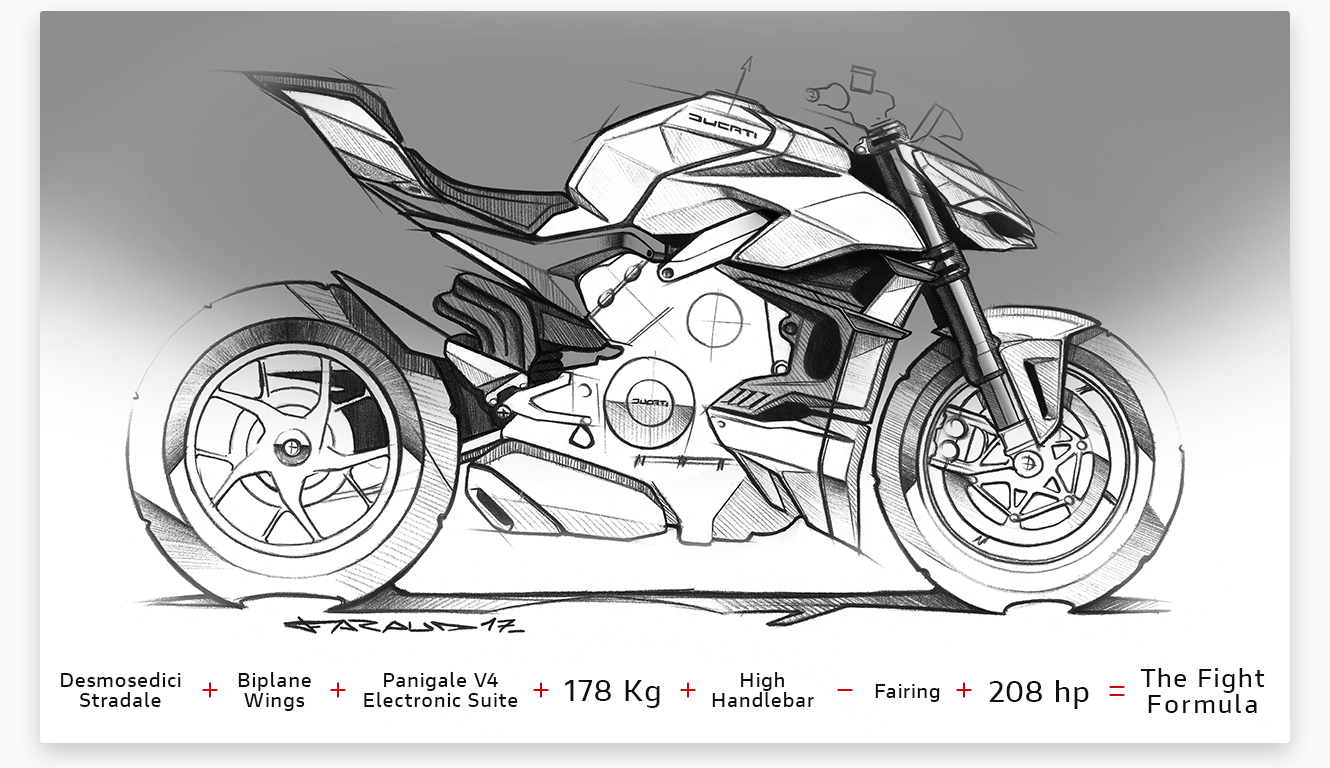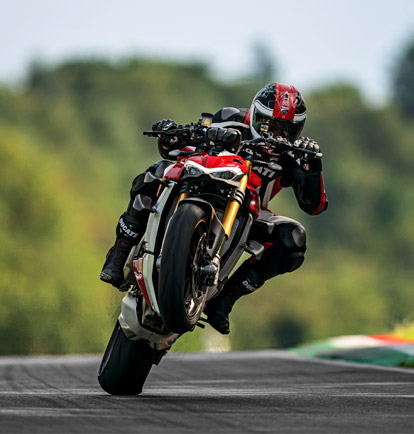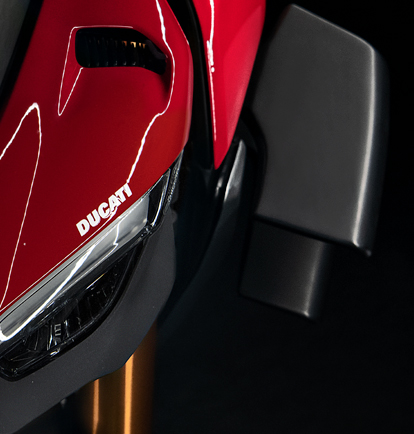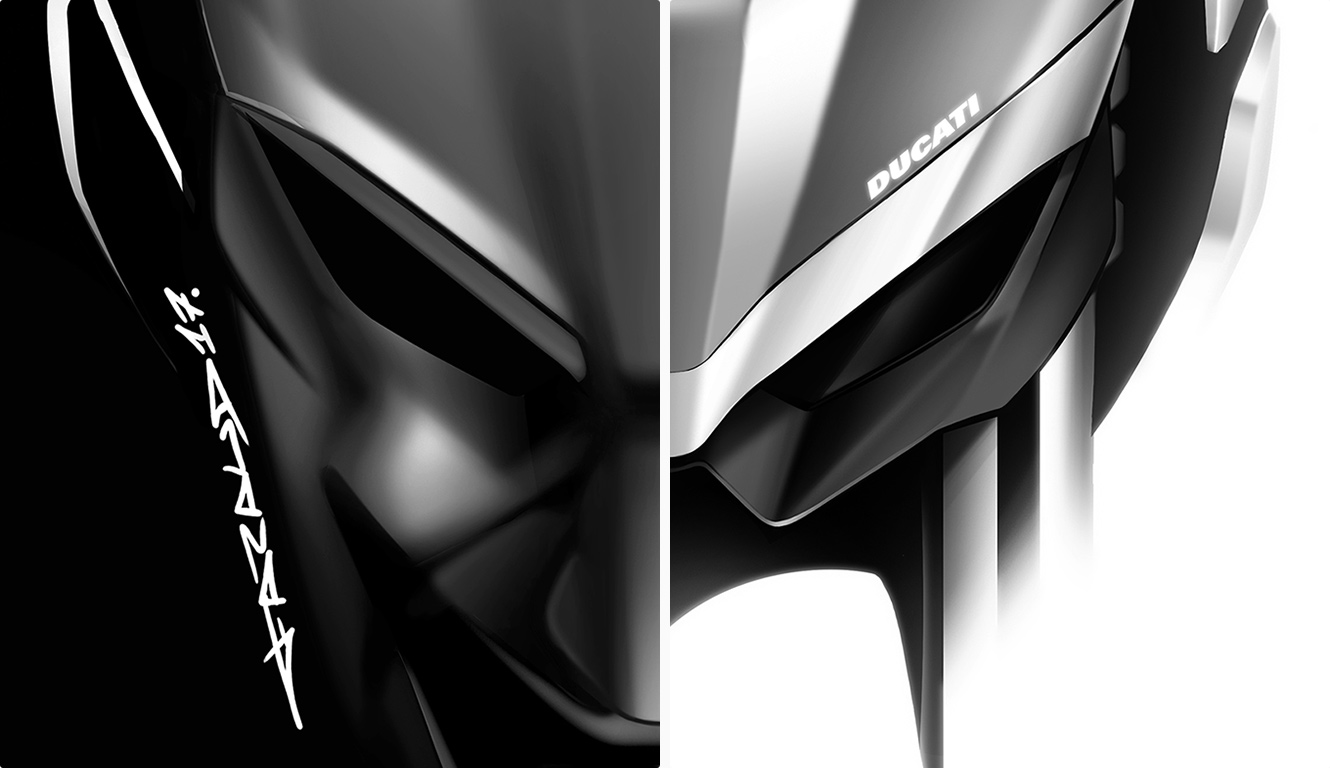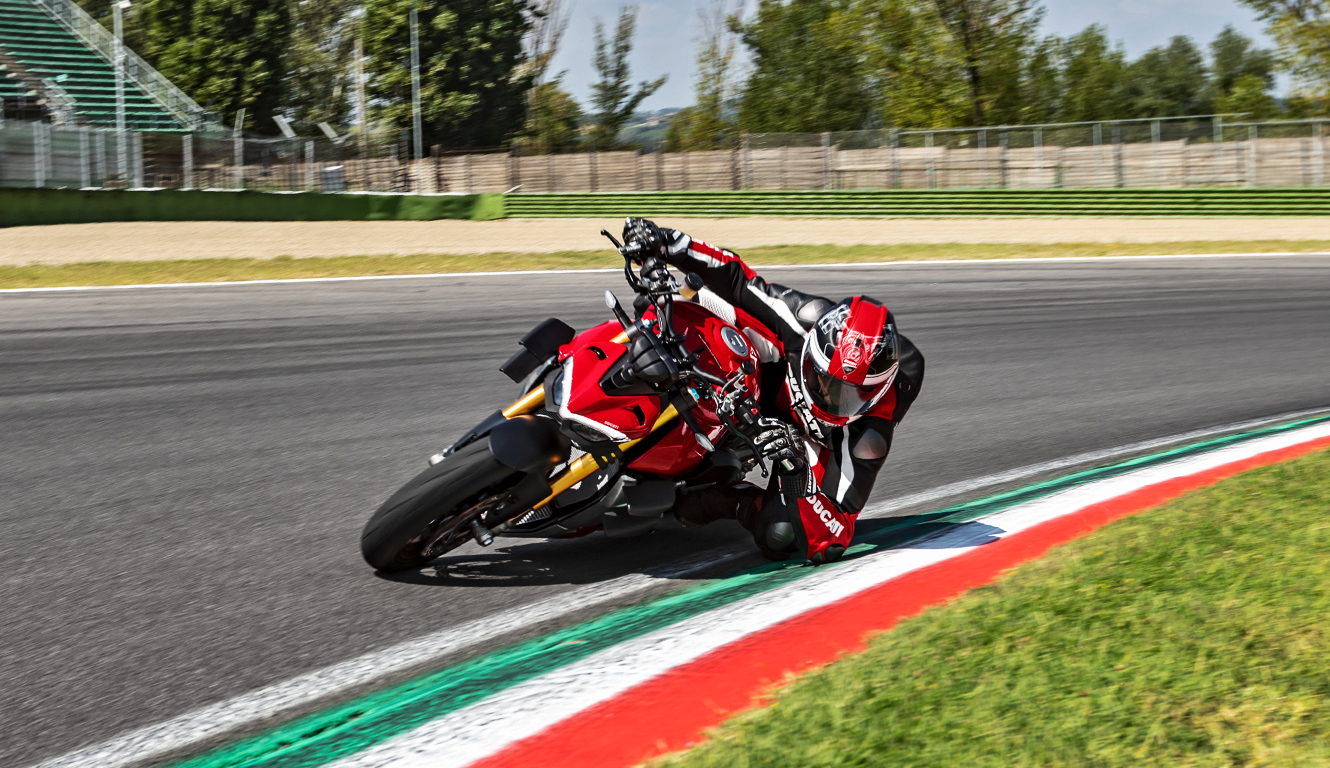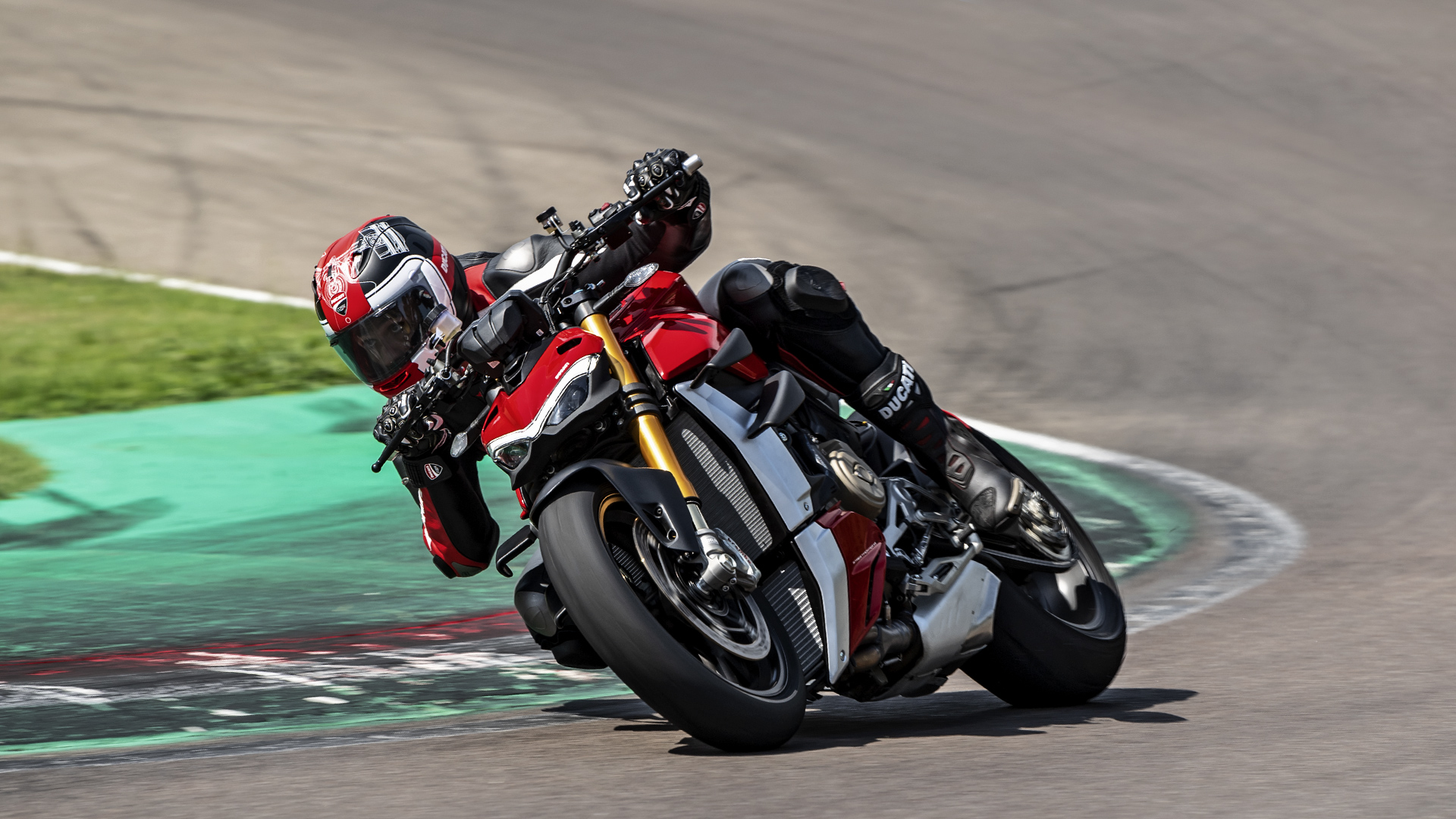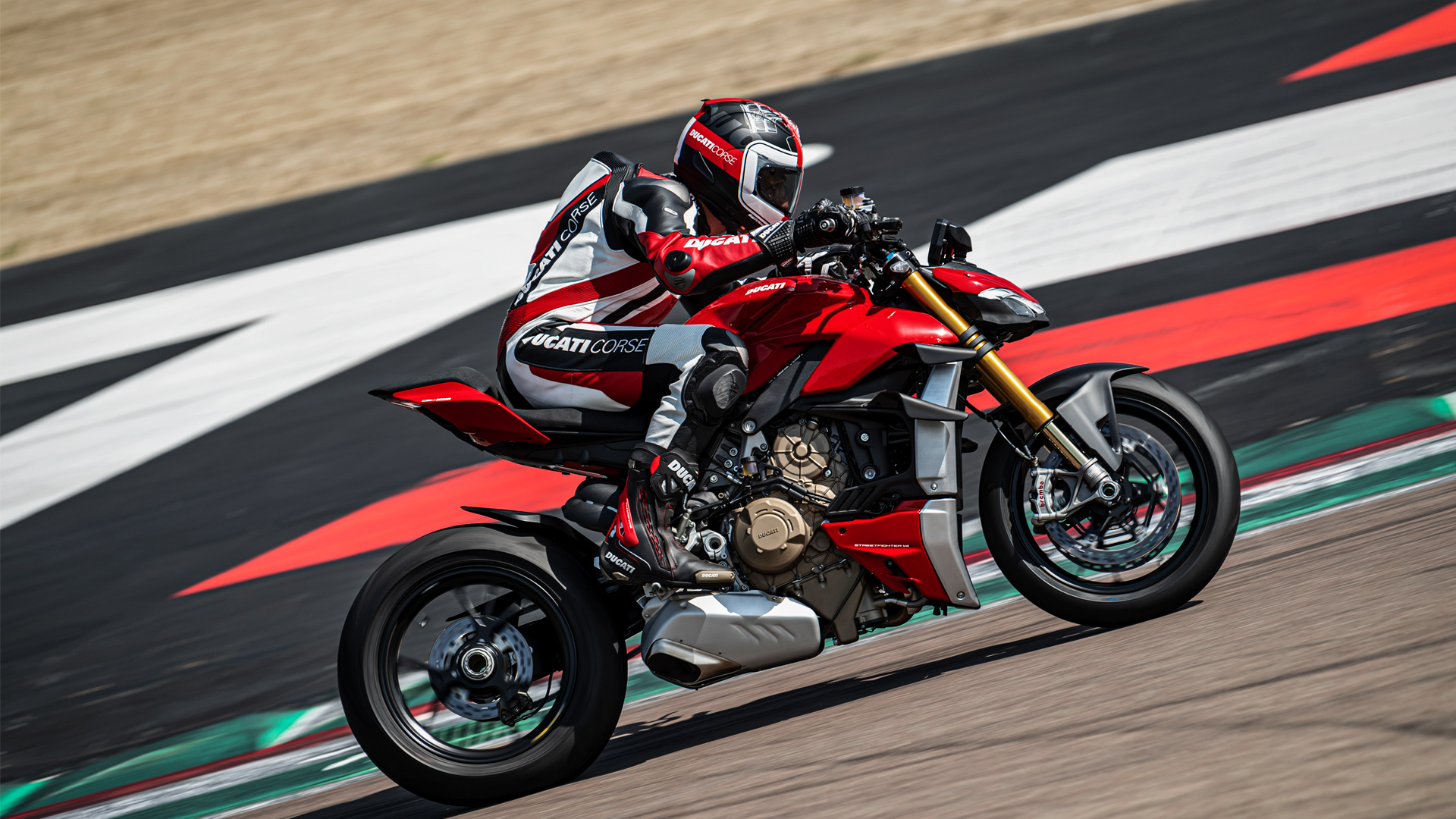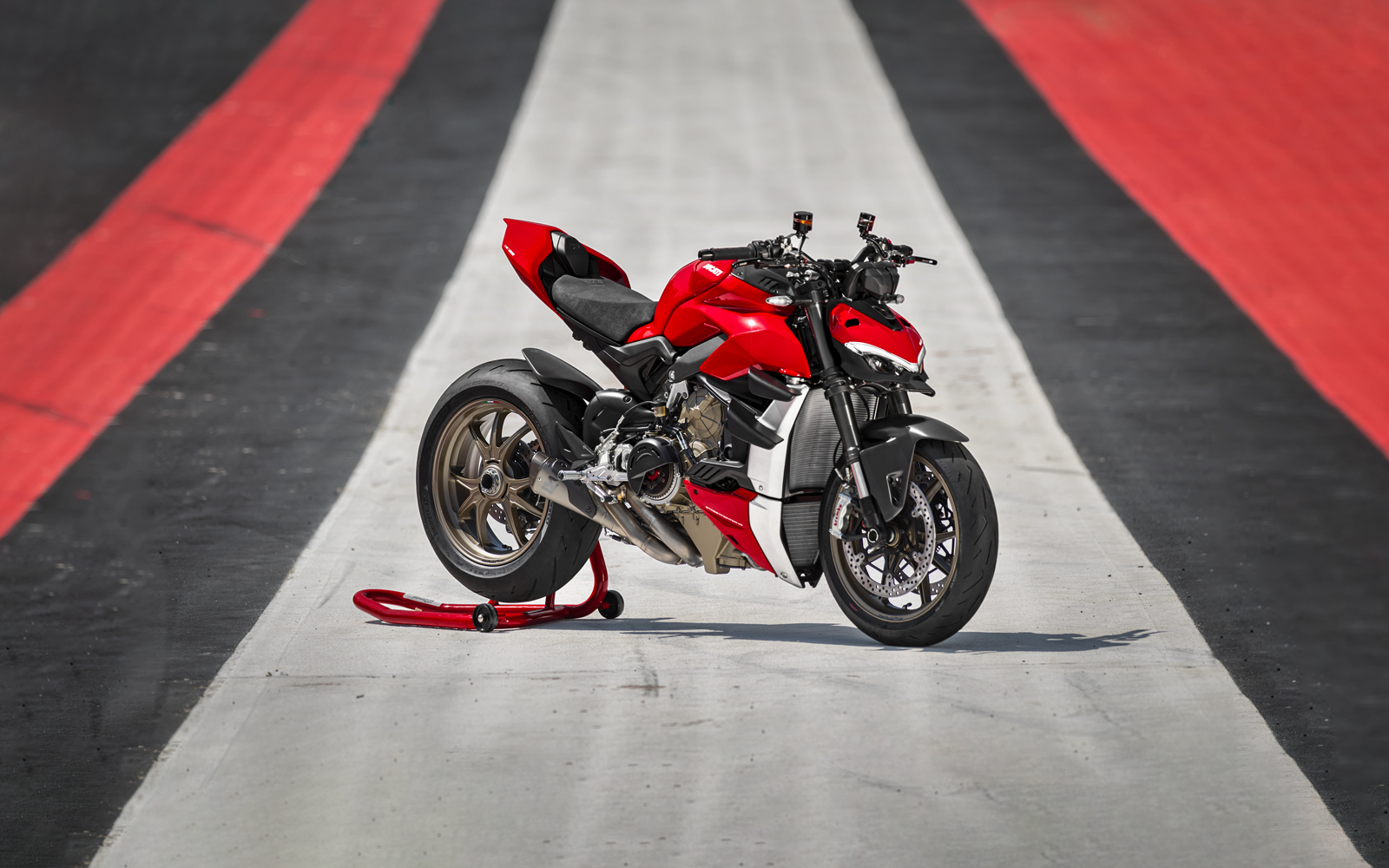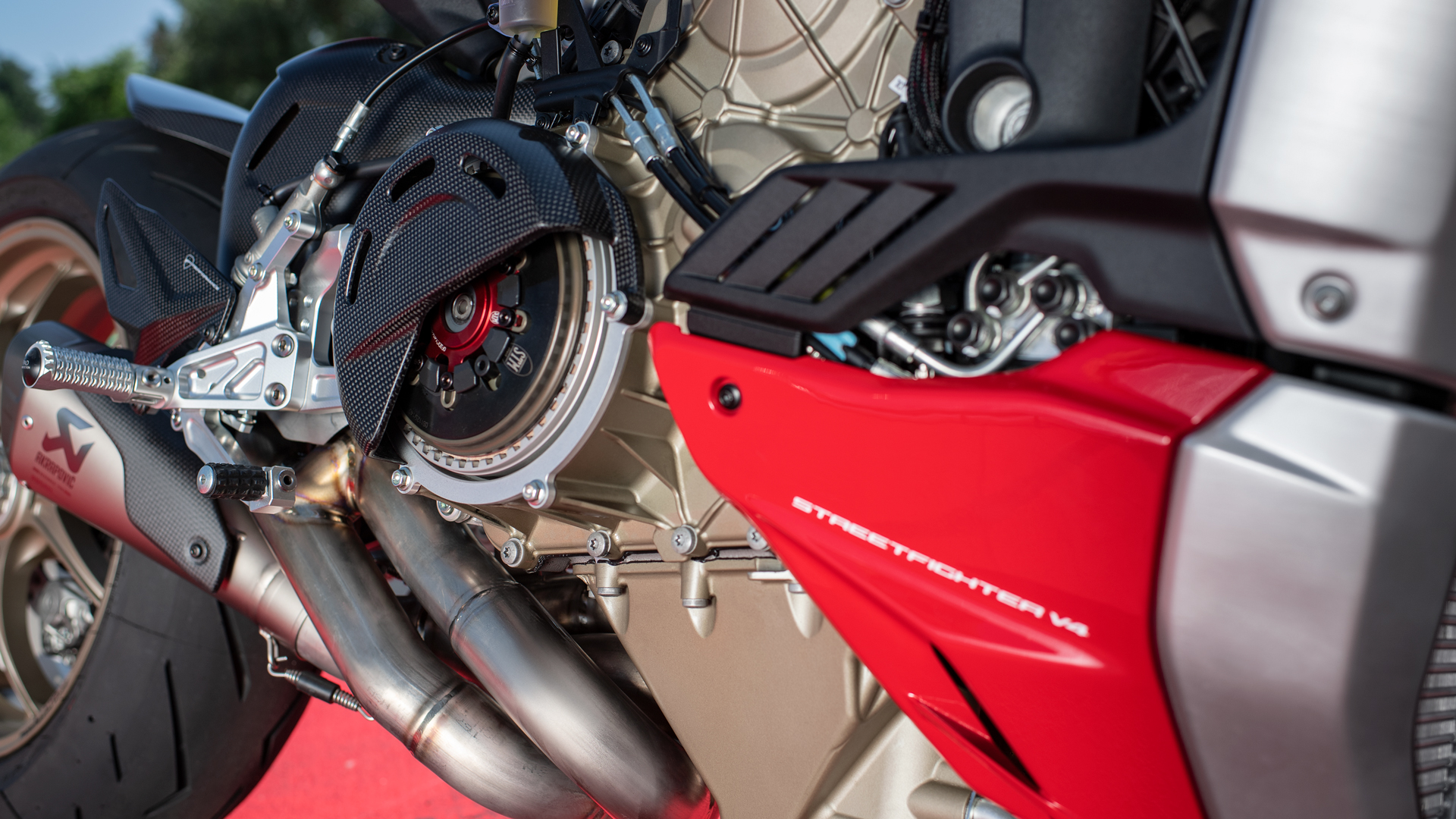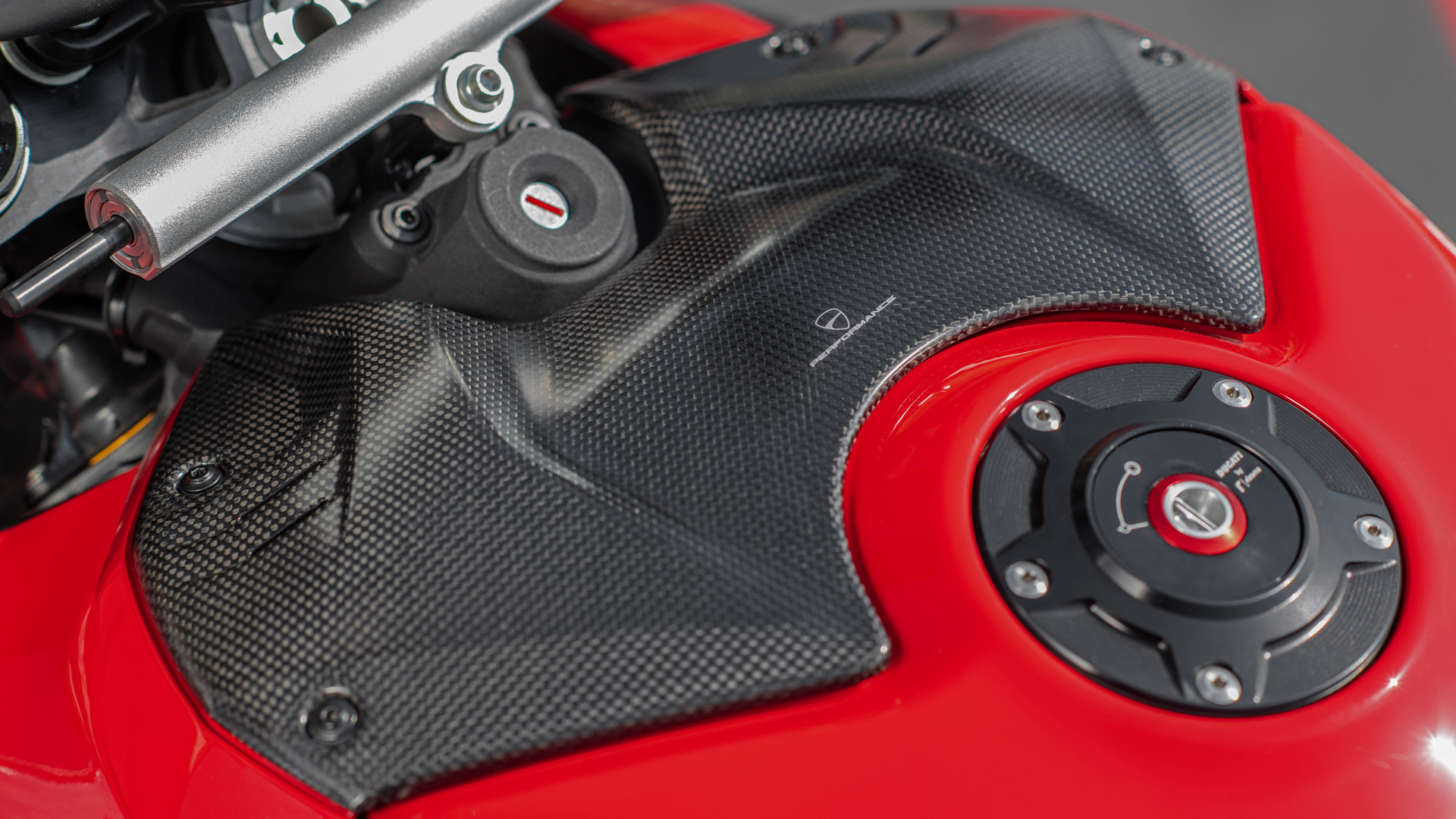For Ducati, the V4 layout at 90° is the utmost expression of sportiness for a motorcycle engine. It is no coincidence that it is the same solution used in the MotoGP Desmosedici engines.
Read more- 170 hp Power
- 125 Nm Torque
- 840 mm Seat Height
The Panigale V4, stripped of its fairings and with high, wide handlebars. This, in short, is the underlying concept of the new Streetfighter V4, a bike that magnifies the thrill of the ride every time it takes to the road.
The result? An unrivalled naked bristling with cutting-edge technology and an awe-inspiring design that oozes pure performance.
The minimalist full-LED headlight captures the spirit of the Streetfighter V4 perfectly. On the one hand, it recalls the front of the Panigale V4 and, on the other, evokes the crazy grin of the Joker (the comic strip character from which the Ducati Style Center drew inspiration for this new Bologna-built naked). Already featured on the Panigale V4 and SuperSport, the V-shaped DRL is another clear Ducati hallmark.
The new Ducati naked V4 told by the words of Ducati CEO Claudio Domenicali during the DWP2020.



|
|
Streetfighter V4
|
Streetfighter V4 S
|
|
DES EVO
|
-
|
✓
|
|
Front Suspension
|
Ø 43 mm Showa BPF fork
|
Ø 43 mm Öhlins NIX30 event-based fork
|
|
Rear Suspension
|
Sachs shock
|
Öhlins TTX36 event-based shock
|
|
Steering damper
|
Sachs
|
Öhlins event-based
|
|
Wheels
|
Aluminum alloy casted
|
Marchesini Aluminum forged
|
|
Dry Weight
|
180 kg (397 lb)
|
178 (392 lb)
|
|
Kerb weight
|
201 kg (443 lb)
|
199 kg (439 lb)
|
Joker face
The minimalist full-LED headlight captures the spirit of the Streetfighter V4 perfectly. On the one hand, it recalls the front of the Panigale V4 and, on the other, evokes the crazy grin of the Joker (the comic strip character from which the Ducati Style Center drew inspiration for this new Bologna-built naked).
Already featured on the Panigale V4 and SuperSport, the V-shaped DRL is another clear Ducati hallmark.
The compact headlight is embedded in a meticulously designed dual-layer fairing that incorporates the air-box and LED cooling intakes; a rear deflector, instead, stops flows impacting the tank directly.
The headlight is surmounted by a 5" TFT screen (the same as the one on the Panigale V4) and features a smartly styled front cover that hides connectors and wiring.
The magic of Aerodynamics
Fast, agile mixed-road performance demands maximum stability at high speed and when braking, reduced wheel-up during acceleration and minimised electronic control of the suspension set-up: that's why Ducati Corse specialists have, together with the Ducati Style Centre, developed biplane wings for the Streetfighter V4.
The aerodynamics were developed using CFD (Computational Fluid Dynamics) simulation. The calculation method involved stationary simulation of flow and pressure to achieve increased downforce, especially on the front wheel.
To reduce lateral protrusion as much as possible, the aerodynamics team decided to adopt a 'biplane' configuration of limited 'wingspan' with upper and lower wings working independently.
Each appendage can be described as a square-plan mono-wing with a winglet on its outer tip. Moreover, the wings have been positioned as close as possible to the front wheel (near the radiator side panels) to maximise the anti wheel-up effect.
These aerodynamic appendages generate 28 kg of downforce at 270 kph (20 kg on the front wheel, 8 kg on the rear). The wings also help draw heat off the engine by increasing water and oil radiator throughflow speeds by 2% and 10% respectively.
Wing-generated downforce attenuates front wheel 'floating' at high speed and the tendency to wheel-up. It also improves stability during braking at the turn-in point and through the corner.
The aerodynamics thus instil confidence and limit intervention by electronic controls. This helps the rider keep the throttle open longer and brake later going into the bends, providing significant performance benefits.
Front Frame
The Streetfighter V4 features the Front-Frame - an offshoot of Ducati's extensive experience in MotoGP - which uses the Desmosedici Stradale engine as a load-bearing member.
Compared to traditional perimeter frames the main lay-out difference is that the engine is used as a structural chassis element. Weighing just 4 kg, the compact Front-Frame is attached directly to the upper crankcase of the front cylinder bank and the cylinder head of the rear bank; the V4 crankcase also provides the rear suspension attachment point and the single-sided swingarm pivot mount.
The key advantage of the Ducati Front-Frame is that it uses the Desmosedici Stradale engine to achieve the desired stiffness: this has resulted in significantly lower main frame length and weight and a better stiffness/weight ratio. Moreover, the struts alongside the engine have been shortened, making bike design more compact, especially in the rider's seat area.
Completing the chassis is the under-seat Trellis subframe, attached to the Front-Frame at the top and bolted to the head of the rear cylinder bank below.
The rear suspension linkage mechanism is attached to the Desmosedici Stradale engine via a forged aluminium bracket. The linkage reacts to movements imparted by a cast aluminium high-truss swingarm.
Steering geometry features a 24.5° rake and 100 mm trail.
High Power
The new Streetfighter V4 is powered by a 1103 cm3 Desmosedici Stradale engine. In this configuration the 90° V4 delivers 208 hp (153 kW) at 12,750 rpm, an unrivalled power level within the naked segment, perfectly in keeping with the all-out character of the new Streetfighter V4. Maximum torque is 123 Nm (12.5 kgm) at 11,500 rpm, practically unchanged with respect to the Panigale V4. Dedicated engine mapping lets riders safely make the most of Streetfighter V4 performance on the road.
The final ratio, shorter than that of the Panigale V4, delivers a wheel torque higher of +10%, which ensures an immediate response to the throttle command.
Power and torque can be raised to 220 hp (162 kW) and 130 Nm (13.2 kgm) by fitting the full-racing Ducati Performance exhaust by Akrapovič that also reduces weight by – 6 kg.
MotoGP-derived engine
The Desmosedici Stradale was designed around the core of the V4 MotoGP engine – the cylinder heads. With the same dimensions and geometry as the Desmosedici GP, the Desmosedici Stradale offers the same outstanding fluid dynamics. It also has the same engine configuration: 90° V4, rotated rearward by 42°.
This solution makes the engine extremely compact, allowing centralisation of mass and flawless integration with the vehicle.
The bore of (81 mm) is the same as that used by the Desmosedici GP engine and is the maximum dimension allowed by MotoGP regulations. It is also the highest in the four-cylinder supersport segment.
The stroke (53.5 mm) is longer compared to the Desmosedici GP engine in order to deliver higher torque on open road use, and to reduce maximum engine rotation speed.
The use of the same bore as the Desmosedici GP engine means that all the fluid dynamics (valves, intake pipes, throttle bodies), which in fact make up the heart of the engine where the performance is generated are also very similar in the two drive units.
The V4 90° layout makes the engine extremely compact, allowing the centring of the masses and better integration into the bike. In fact, the Desmosedici Stradale has been inserted into the vehicle with the front bank of the cylinders rotated back by 42° with respect to the horizontal plane, as on the Ducati engines competing in MotoGP. This optimises the distribution of weight, allows for the use of more extensive radiators and makes it possible to shift the swinging arm pivot forwards.
Its architecture also generates a natural balancing of first-order forces, without the gain in weight and loss of power of a balance shaft.
For Ducati, the V4 layout at 90° is the utmost expression of sportiness for a motorcycle engine. It is no coincidence that it is the same solution used in the MotoGP Desmosedici engines.
Read more
For Ducati, the V4 layout at 90° is the utmost expression of sportiness for a motorcycle engine. It is no coincidence that it is the same solution used in the MotoGP Desmosedici engines. The 90° V layout of the cylinders creates a natural balancing of first-order forces without the need to resort to a balance shaft to eliminate the vibrations that notoriously entail increases in weight and power absorption.
In addition to this primary benefit, which is extremely important for the reliability and mechanical efficiency of an engine that reaches rotation speeds greater than 14,000 rpm, there are others that make the configuration chosen by Ducati the most technically refined.
Compared to a classic in-line four-cylinder, the lateral compactness of the V-engine allows greater centralisation of the masses and makes it possible to limit the weight on the front end of the bike. Furthermore, the shorter crankshaft generates a smaller gyroscopic effect. All these aspects have a positive impact on the bike's dynamics, helping to make it light and fast when changing directions.
Read more
Compared to a classic in-line four-cylinder, the lateral compactness of the V-engine allows greater centralisation of the masses and makes it possible to limit the weight on the front end of the bike. Furthermore, the shorter crankshaft generates a smaller gyroscopic effect.
All these aspects have a positive impact on the bike's dynamics, helping to make it light and fast when changing directions. The large space available between the V of the cylinders made it possible to position the water pump and have a large volume airbox (12.8 litres) to allow the Desmosedici Stradale to breathe better.
The optimal integration of engine and chassis is a fundamental concept behind every Ducati project. That is why the Desmosedici Stradale was developed to be mounted rotated backwards by 42°, like the Ducati MotoGP engines, to optimise weight distribution, use more extensive radiators and to shift the swinging arm pivot forwards as much as possible.
Read more
The optimal integration of engine and chassis is a fundamental concept behind every Ducati project. That is why the Desmosedici Stradale was developed to be mounted rotated backwards by 42°, like the Ducati MotoGP engines, to optimise weight distribution, use more extensive radiators and to shift the swinging arm pivot forwards as much as possible.
The Desmosedici Stradale was also designed to be a structural element of the frame. Connections to the main frame were added to the front of the upper casing and in the head of the rear bank. The engine block also acts as a connection for the rear suspension and swinging arm.
Like all Ducati engines, on the Desmosedici Stradale the design of the Desmodromic system is a key factor for obtaining top performance. The Desmodromic system in the Desmosedici Stradale uses components that have been completely redesigned and miniaturised to obtain very compact heads, achieving a level of sophistication, compactness and lightness never seen before on a Ducati bike.
Given the V4's high rotation speeds and the large size of the valves, the latter could not follow the cam closure profiles using a traditional spring system. This is why the Desmodromic system becomes indispensable.
In Ducati's "Desmo" the valves are mechanically closed with an accuracy similar to that of the opening phase, making it possible to realise more pronounced cam profiles and extreme timing that optimise the dynamic flow of fluids both during intake and exhaust and therefore greater performance of the engine.
The camshafts are controlled by two “silent” timing chains.
On the front timing system the chain drives the intake camshaft, which in turn transmits motion to the exhaust via a pair of gear wheels (mixed chain-gear timing system). On the rear timing system, on the other hand, the chain drives the exhaust shaft which transmits motion to the intake line. This choice minimises timing absorption, benefiting performance and reliability.
The chain that controls the timing of the front cylinders is positioned on the right side of the engine and is driven by the crankshaft through a gear on the sprocket of the primary transmission. The one that drives the rear cylinders is situated on the left side of the engine and is driven by a gear that is part of the crankshaft. Each head has an "anti-beat" sensor that makes it possible to optimise the management of advance firing, avoiding knocking phenomena.
On normal motorcycles the crankshaft rotates in the same direction as the wheels. In contrast, in MotoGP the counter-rotating crankshaft rotates in the opposite direction. The Ducati engine specialists have borrowed this technical solution from the racing models for the same reasons it was applied in the competitive world. In fact, this solution has advantages related to two aspects of physics: the gyroscopic effect and inertia.
Read more
On normal motorcycles the crankshaft rotates in the same direction as the wheels. In contrast, in MotoGP the counter-rotating crankshaft rotates in the opposite direction. The Ducati engine specialists have borrowed this technical solution from the racing models for the same reasons it was applied in the competitive world. In fact, this solution has advantages related to two aspects of physics: the gyroscopic effect and inertia. The counter-rotating crankshaft makes it possible to compensate part of the gyroscopic effect produced by the wheels while riding, and this results in improved handling and a motorcycle that is more agile when changing direction.
The second advantage is related to inertia (that is, the tendency of an object to oppose a change in state) both of the vehicle and the rotating engine parts. During acceleration, the driving torque transmitted to the ground pushes the vehicle, which reacts by generating a tendency to do a wheelie. Due to inertia, the counter-rotating crankshaft generates a torque in the opposite direction, which thus tends to lower the front end thereby reducing the wheelie phenomenon, with also benefits acceleration.
Likewise, during braking or fast decelerations, the motorcycle experiences a reaction that tends towards rear lift-up, but the crankshaft also undergoes a deceleration (reduced rpms) and this results in an inertial torque in the opposite direction that counters the force seeking to lift the rear end. Consequently, both in acceleration and braking, the adoption of the counter-rotating shaft provides positive effects.
Clearly, this layout requires an additional toothed wheel, the so-called idle wheel, which is necessary to transfer the crankshaft motion to the gearbox and then to the wheels so as to provide the correct rotation for the direction of travel.
The 70° offset of the crank pins combined with the 90° V-engine layout generates a firing order that Ducati has called "Twin Pulse" because it is as if the engine were reproducing the firing sequence of a twin cylinder. The peculiarity lies in the rapid firing of the two cylinders on the left side and then on the right side of the motorcycle. In the timing diagram, the firings are situated at 0°, 90°, 290° and 380°. This particular firing order gives the V4 a sound that is quite similar to that of the Desmosedici MotoGP.
Read more
The 70° offset of the crank pins combined with the 90° V-engine layout generates a firing order that Ducati has called "Twin Pulse" because it is as if the engine were reproducing the firing sequence of a twin cylinder. The peculiarity lies in the rapid firing of the two cylinders on the left side and then on the right side of the motorcycle. In the timing diagram, the firings are situated at 0°, 90°, 290° and 380°. This particular firing order gives the V4 a sound that is quite similar to that of the Desmosedici MotoGP.
In practice, imagining a cycle that starts with 0°, the first cylinder of the front bank "fires", generator side, followed, after only 90° of rotation, by the rear bank cylinder on the same side. Then there is an interval during which the engine does not generate drive torque until the firings 90° from each other in the two cylinders on the clutch side.
The "Twin Pulse" firing order, besides producing a unique exhaust sound unlike any other motorcycle, music to the ears of a true enthusiast, generates a type of power that was judged to be the best by the Ducati MotoGP riders as it generates important advantages at the power level and therefore the rideability of the motorcycle, especially when cornering and coming out of curves.
Magnesium occupies a prominent position among the lighter metal materials. It is not by chance that in alloy form it is widely used in competitions. The Desmosedici Stradale uses magnesium alloy for numerous components, including head covers, oil sump, generator and clutch. A technical choice that also has a positive impact on the bike's look.
Pistons having a diameter of 81 mm churn in the barrels of the cylinders, with two piston rings, low friction, plus oil scraper ring. They are moulded in aluminium and utilise the "box in box" technology that makes it possible to contain the skirt height and the thickness under the piston crown thus reducing friction and inertia loads while maintaining the required durability and stiffness.
The perfect functionality of the six-speed gearbox is enhanced by the Ducati Quick Shift EVO (DQS EVO), which offers a fundamental evolution: changing gears with the throttle open. Furthermore, DQS EVO follows different logics to shift up and down. Integration with the slipper clutch and engine brake (Engine Brake Control) ensures the system's absolute effectiveness even on the track.
The wet clutch with progressive control optimally combines high torque drive and rider comfort. In competitive riding conditions, with sudden downshifts and strong engine braking, the slipper clutch counteracts the loss of stability of the rear end, offering excellent control while braking deep in corners.
Like the MotoGP engines, the Desmosedici Stradale uses a semi-dry casing lubrication with delivery and recovery stages to ensure proper lubrication of all moving parts at all times.
Read more
Like the MotoGP engines, the Desmosedici Stradale uses a semi-dry casing lubrication with delivery and recovery stages to ensure proper lubrication of all moving parts at all times.
The oil pump, driven by a chain, consists of four stages, one for lobe delivery and three for recovery, one with gears to draw oil from the heads through two ducts, while the other two pumps have lobes and ensure effective recovery of lubricating oil in any condition of engine use, while maintaining the engine crankcase underneath the pistons under controlled constant vacuum conditions, reducing losses due to ventilation, that is, the power absorption caused by the aerodynamic resistance offered by the air and the beating of the oil present in the connecting rod compartment.
The oil tank, which also serves as a filter housing, is situated in a magnesium oil sump mounted under the crankcase and connected to the gearbox compartment, but separate from the crankcase. For cooling the oil a dedicated radiator is used, secured below the water cooler.
Air intake is entrusted to four oval throttle bodies (52 mm diameter equivalent) connected to fixed 70 mm long intake horns. Each throttle body has two injectors: a sub-butterfly one for low-load use and another above it that comes into play when maximum engine performance is required. The throttle bodies of each cylinder bank are moved by a dedicated electric motor.
Thanks to the full Ride by Wire system, this allows complex electronic control strategies and modulation of engine 'feel' according to selected riding mode.
To increase urban riding comfort the rear cylinder bank is deactivated at idle when water temperature exceeds 75°.
Long maintenance intervals
Valve play adjustment (Desmo Service) is required every 24,000 km; services are performed every 12,000 km/12 months.
Ergonomics, more comfort, more control
Compared to the Panigale V4, the riding position - with an above-ground height of 845 mm - has been redefined as per the specifications of a naked model. In keeping with streetfighter culture, the semi-handlebars have been replaced by a high, wide bar that, together with a seat with 60 mm of foam thikness and moderated footpeg position, ensures sports-style comfort during inner city rides and the control needed to tackle country roads or racetracks.
While maintaining many of the Panigale's stylistic features, the tail is supported by a steel subframe and has been redesigned to enhance passenger comfort and give the rider more lengthways space.
Front Frame
The Streetfighter V4 features the Front-Frame - an offshoot of Ducati's extensive experience in MotoGP - which uses the Desmosedici Stradale engine as a load-bearing member.
Compared to traditional perimeter frames the main lay-out difference is that the engine is used as a structural chassis element. Weighing just 4 kg, the compact Front-Frame is attached directly to the upper crankcase of the front cylinder bank and the cylinder head of the rear bank; the V4 crankcase also provides the rear suspension attachment point and the single-sided swingarm pivot mount.
The key advantage of the Ducati Front-Frame is that it uses the Desmosedici Stradale engine to achieve the desired stiffness: this has resulted in significantly lower main frame length and weight and a better stiffness/weight ratio. Moreover, the struts alongside the engine have been shortened, making bike design more compact, especially in the rider's seat area.
Completing the chassis is the under-seat Trellis subframe, attached to the Front-Frame at the top and bolted to the head of the rear cylinder bank below.
The rear suspension linkage mechanism is attached to the Desmosedici Stradale engine via a forged aluminium bracket. The linkage reacts to movements imparted by a cast aluminium high-truss swingarm.
Steering geometry features a 24.5° rake and 100 mm trail.
Sophisticated suspension
The Streetfighter V4 mounts 43 mm Showa Big Piston Forks (BPF) to provide full adjustability in spring pre-load and compression and rebound damping.
The fork bodies house chrome sliders with Brembo radial caliper mountings. A Sachs steering damper completes the front-end package. At the rear there is a fully adjustable Sachs shock absorber, one side of which is attached to the Desmosedici Stradale engine via a forged aluminium bracket.
The Streetfighter V4 S, instead, is equipped with an Öhlins NIX-30 fork, an Öhlins TTX36 rear shock absorber and an Öhlins event-based steering damper. On this version suspension and steering damper are controlled by the second-generation Öhlins Smart EC 2.0 system which, among other things, features the new OBTi (Objective Based Tuning Interface).
Wheels and tyres
While the Streetfighter V4 mounts cast aluminium 5-spoke wheels, the V4 S is equipped with 3-spoke Marchesini forged aluminium alloy wheels.
The rims mount Pirelli Diablo Rosso Corsa II tyres. Combining track performance with road versatility, they come in the 120/70 ZR17 (front) and 200/60 ZR 17 (rear) sizes, already used extensively for slick tyres in the FIM Superbike World Championship.
The rear tyre compound has been designed by Pirelli specifically for the Streetfighter V4. It ensures the same dynamic behaviour as the Supercorsa SP race replica tyres mounted on the Panigale V4, but has better low temperature performance to ensure the versatility one expects from a naked.
Braking system with Brembo Stylema® monobloc calipers
The Streetfighter V4 range features powerful Brembo Stylema® monobloc calipers, developed out of the already high performance M50 calipers.
The dual Brembo calipers, each mounting four 30 mm pistons, bite down on 330 mm discs to give exceptional braking power. Rear braking, instead, relies on a single 245 mm disc clamped by a 2-piston caliper. Braking is aided by the ABS Cornering EVO system, which uses the ultra-light 9.1MP control unit.
Racing tank
As on racing bikes, the 16-litre aluminium tank has a section that extends under the seat. Compared to the Panigale V4, the lower section of the tank has been modified to allow installation of a seat with thicker padding to boost rider comfort.
Up front, the space not occupied by fuel has been used to house all the electronics, battery included.
MotoGP-derived electronics
The latest-generation electronics package on the Streetfighter V4 is based on a 6-axis Inertial Measurement Unit (6D IMU) which instantly detects the bike's roll, yaw and pitch angles.
The electronics package has controls for every part of the ride: some oversee start, acceleration and braking, others govern traction and others again lend a helping hand on corners and out-of-the-corner stretches.
Operational parameters for each of these controls are associated by default with the three Streetfighter V4 Riding Modes. Riders can personalise parameters to suit their riding style or restore Ducati factory settings. DTC, DWC, DSC or EBC control levels can be adjusted quickly via the left switchgear.
Second-generation TFT instrumentation
The Streetfighter V4 features the same 5" full-TFT high resolution colour screen (186.59 PPI - 800xRGBx480) as the Panigale V4. The dashboard is dominated by the round virtual rev counter on the right. Desmosedici Stradale revs are displayed on a needle gauge.
Movement of the latter is accompanied by a white trail that acts as a 'shift light', changing colour from white to orange and then red as the rev limit approaches.
The rider can call up two different lay-outs: 'Track' highlights the lap times and the rev counter scale makes the revs typical of track use more clearly visible; 'Road', instead, replaces lap times with info on the Ducati Multimedia System (DMS), where present, and the rev scale is more appropriate for road use.
Riding Modes provide users with three different pre-set riding styles so that Streetfighter V4 performance can be adapted to rider, track/route and weather conditions. Changing the Riding Modes instantaneously changes the character of the engine, the electronic control parameters and, on the S version, the suspension set-up too.
read more
Race Riding Mode
As the name suggests, Race RM allows riders, including those who are less expert, to enjoy excellent bike performance on high-grip track surfaces. By selecting Race, the rider can count on 208 hp, with direct Ride by Wire throttle response and, on the S version, a firm suspension set-up to optimise performance. Race mode sets the electronics at a low intervention level but without lowering safety, with ABS set to level 2, lift-up control off and the 'slide by brake' function (which lets riders drift the bike into corners safely) on.
Sport Riding Mode
Selecting Sport gives the rider 208 hp, with direct sport-style Ride by Wire throttle response and, on the S version, a sport style suspension set-up. Electronic controls are set to give riders perfect dry road ride responsiveness. Rear wheel lift detection during braking is on and the ABS Cornering function is set to maximise cornering performance.
Street Riding Mode
Street mode is recommended when riding on surfaces with poor grip. This RM gives the rider 155 hp and progressive Ride by Wire throttle response and, on the S version, a suspension set-up that is well suited to bumpy or pitted roads. Electronic control settings ensure grip and stability to maximise safety.
Riders can personalise settings to suit their riding style and subsequently restore Ducati-set parameters. They can also enable ABS Level 1 (intended for on-track use by highly expert riders) which acts on the front wheel only to allow full-on braking performance.
The ABS system on the Streetfighter V4 features the cornering function (which keeps the ABS working even with the bike leaned over) and has the same intervention logic and control as the Panigale V4. ABS Cornering EVO can be set at three different levels to fully satisfy the needs of all riders, on racetrack or road, even under critical low-grip conditions.
read more
Level 3 is recommended for road riding or where there is poor grip; it ensures safe and stable braking and keeps rear wheel lift under constant control during hard deceleration. Levels 2 and 1 prioritise braking power and are intended for use on high-grip surfaces or racetracks.
Amateur riders enjoying a track day are advised to use Level 2. The system controls both the rear and front braking systems, keeps the cornering function on but disables lift-up control to allow harder, sportier braking. Selecting Level 2 activates the 'slide by brake' function, letting riders drift into bends spectacularly yet safely.
Level 1 is not the default setting on any Riding Mode: it is recommended for on-track use by expert riders. It ensures racing-standard ABS intervention on the front wheel only. To maximise performance, both the cornering and anti lift-up functions are disabled.
The new Ducati Traction Control (DTC) EVO 2 strategy is an offshoot of the Ducati Desmosedici GP18 and is already employed on the Panigale V4 R and V4 R SBK.
read more
In addition to interfacing with the 6-axis Inertial Measurement Unit (IMU) and adapting intervention on the basis of wheelspin and lean angle, the software significantly improves out-of-the-corner power control thanks to a new 'predictive' strategy. Acting not just on the basis of instantaneous rear wheelspin but also its variation, it intercepts any loss of grip sooner and reduces peak wheelspin, ensuring faster, smoother intervention. All this means augmented out-of-the-corner stability (even in sub-optimal grip conditions), higher acceleration, better lap times and improved long run performance.
In addition to controlling spark advance and injection, the DTC EVO 2 system uses, in all situations not requiring fast intervention, the throttle body valves to maintain optimal combustion parameters and ensure more fluid engine response and control.
DTC EVO 2 can be set to 8 different levels (6 for dry conditions, 2 for wet), letting riders adapt control strategy to their individual riding styles and grip conditions to maximise performance.
The introduction of the 6D IMU has allowed Ducati Slide Control (DSC) - developed jointly with Ducati Corse - to be added to Ducati Traction Control (DTC) EVO.
read more
This system assists riders by controlling the torque delivered by the Desmosedici Stradale engine according to slide angle. Its purpose is to improve-out-of-the-bend performance by preventing slide angles that would otherwise be difficult to handle. The DSC relies on the 6D IMU that provides the vehicle control unit with crucial information on bike dynamics (such as lean angle, acceleration and much more).
Like DTC EVO, DSC controls torque reduction by acting on the throttle body valves, decreasing spark advance and reducing injection. In every situation in which fast intervention of the DSC is not required, use of the throttle body valves ensures maintenance of optimal combustion parameters, resulting in more fluid Desmosedici Stradale engine response and intervention.
DSC has two different settings: switching from level 1 to level 2 gives easier control of slide angles that would otherwise be hard to manage. DSC intervention levels can be changed via the menu, which the rider can also use to adjust DTC EVO and DWC EVO settings. It's also possible to set direct DSC control via direct access buttons on the left switchgear. The DSC setting is always shown on the display.
The Streetfighter V4 also comes with the latest version of Ducati Wheelie Control (DWC) EVO.
read moreThis 3-level system ensures lightning-fast starts, letting the rider focus on releasing the clutch. Once set, all the rider has to do is engage first gear and open the throttle.
read moreDuring the initial moving-off stage, as the rider modulates clutch release, DPL stabilises the engine at optimal revs according to the selected level. In the second stage, when the clutch has been fully released, DPL controls torque delivery to maximise acceleration on the basis of the selected level. The DPL makes use of the DWC functions and always keeps DTC active to ensure complete safety at all times. Automatic system disengagement occurs above the end-of-start speed, or once third gear is selected. To protect the clutch, a specially developed algorithm allows only a limited number of consecutive starts. The number of available starts is reset when the bike is ridden routinely. The DPL has three different settings and is activated by pressing the specific key. Level 1 favours high-performance starts, level 3 is safe and stable.
DQS EVO 2 with up/down function, developed for the Panigale V4, uses lean angle data to maximise bike stability when shifting gears through the bends.
read moreIn addition to minimising shift times, DQS EVO 2 allows clutchless down-changes, making hard braking more effective than ever. The system includes a two-way microswitch built into the shift lever linkage; every time the gear shift is actuated, it sends a signal to the Desmosedici Stradale engine control unit. Thanks to full Ride-by-Wire control, the system works differently for up-changes and down-changes, integrating spark advance and injection adjustment during up-shifts with an auto-blipper function during down-shifts. Extent and duration of system operation are designed to ensure seamless shifting even during extreme track sessions; during down-shifts the system works in concert with the anti-patter clutch and Engine Brake Control (EBC). DQS EVO 2 - another Panigale V4 R offshoot - reduces up-shift times, allowing the sportier high-rev gear shifts (over 10,000 rpm) typical of track riding and boosting shift stability during aggressive acceleration and cornering.
The EBC (Engine Brake Control) system was developed to help riders optimise bike stability under extreme turn-in conditions; it does so by balancing the forces applied to the rear tyre under severe Desmosedici Stradale engine braking conditions.
read moreThe Streetfighter V4 EBC EVO system, optimised according to lean angle, monitors the throttle body valve position, selected gear and Desmosedici Stradale crankshaft deceleration during aggressive braking and adjusts throttle aperture to balance out the torque forces applied to the tyre. EBC EVO has three different settings, integrated into the Riding Modes.
DLT GPS, available as a Ducati Performance accessory, automatically records and saves lap times and displays them directly on the dashboard each time the bike crosses the finish line, the coordinates of which are set by pressing the flasher button.
read moreIf a lap time is the best of the current track session, the Best Lap function causes it to flash for 5 seconds. At every lap - for a total of 15 consecutive laps - DLT GPS records lap time, maximum rpm and maximum speed; the information can be called up from the relevant menu. DLT GPS is available as a Ducati Performance plug-and-play accessory.
The Ducati Data Analyser + GPS (DDA + GPS) allows assessment of bike and rider performance by showing traces for specific data items.
read moreDDA + GPS is a vital on-track performance monitoring tool. Not only does it automatically display and record Streetfighter V4 lap times, it also saves other data traces such as throttle opening, bike speed, engine rpm, selected gear, engine temperature, distance travelled, rpm and DTC. DDA + GPS is available as a Ducati Performance plug-and-play accessory.
Streetfighter V4 versatility is also evident in the fact that it's ready for the Ducati Multimedia System (DMS). This lets riders take incoming calls, select and listen to music tracks or receive text messages via a Bluetooth link.
read moreWhen the rider mounts the motorcycle the smartphone automatically connects to the bike via Bluetooth, letting the rider control the main multimedia functions. The TFT display shows the track being played, the new text message icon or caller's name. Phone call audio and music are transmitted to the helmet earpieces. DMS is available as a Ducati Performance plug-and-play accessory.
Complete titanium exhaust assembly
Made exclusively by Akrapovič with the Ducati experience. It is the most advanced racing assembly available on the market.
Each section of the system is manufactured in a special titanium alloy that is both lightweight and resistant to high temperatures, allowing for an overall reduction in the bike's weight. Once installed on the bike, the exhaust dramatically increases the already excellent weight-topower ratio of the Panigale, for breathtaking accelerations and stretches.
Thanks to its experience in the races has developed the qualities of the motorcycle and exhaust to their maximum levels to create a perfect synergy, specifically for this exhaust, recalibrating the many and fundamental electronic aids: DTC, DWC, DPL and Slide on demand.
Weight reduction [kg] 6.0. Power at medium rpm [hp] +6% ; Torque at medium rpm [Nm] +6%; Max. Power [hp] +6%; Max. Torque [Nm] +6% .
Dry clutch kit
Just like in MotoGP, where the only thing that matters is utmost performance, the dry clutch is made available for the new Streetfighter V4.
This is an STM EVO-SBK clutch made from billet aluminium with housing and 48-tooth plate pack. The plates are 9 driven and 9 lined with a diameter of 138 mm.When racing on the track there are important benefits in ease of handling.
Specifically, the dry clutch ensures a more effective slipper function, even during the most aggressive downshifts, and greater fluidity during all "off-throttle" stages. In addition, the "mechanical" engine brake level can be customised by choosing a different secondary spring from those available from the catalogue.Other important advantages are the absence of resistance from the engine oil and cleaner oil since the plate wear dust is not conveyed into the lubrication circuit.
The racing character of the dry clutch is an exciting added benefit for the most passionate Ducatistas.
Dry clutch cover
Designed to offer optimum ventilation of the dry clutch during track use, enhancing its characteristic sound. The lightness and strength of the carbon fibre combine with the race-ready look in an accessory that has a uniquely sporty DNA.
Magnesium rims
The unmatched lightweight performance of forged magnesium meets style – a signature 9-spoke design that combines class, high performance and weight saving. This set of rims is approved for single-seat use only.
Adjustable rider footpegs in aluminium
Developed thanks to the experience of Rizoma. Made of high quality anodised aluminium alloy that maintains its original appearance over time.
Adjustable in six positions, they allow the rider to find the position that best suits their build and riding style. Equipped with fold-away brake and gearchange pedals to minimise the risk of breakage in the event of a slip.
They use the standard DQS, which can be configured both as a traditional shift and as a reversed/racing shift. An essential accessory for the most demanding riders.
Racing pair of handgrips
Inspired by the racing world, these handgrips ensure an excellent grip in every riding situation. Built to avoid accidental slipping of the hand and to reduce the vibrations felt.
Carbon tank cover
A splendid detail that embellishes the front of the Streetfighter V4 tank in a way that only carbon fibre can. The finishing and lines of this accessory are perfectly integrated into the racing look of the latest bike made at Borgo Panigale.
